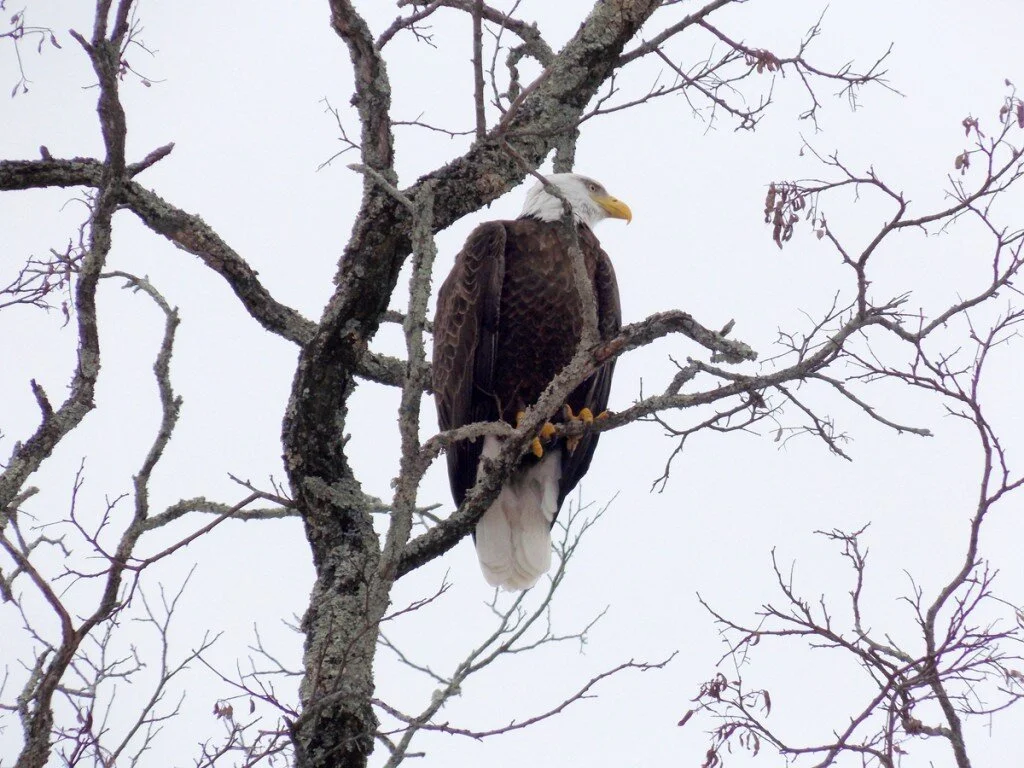Three eagles, two mature and one immature, stationed themselves at the head of the Lake eating any leftovers the ice fisherman threw on the ice, as well as a deer carcass. We’ll see if they stay around for their breeding and nesting season. The presence of these carnivorous predators would certainly be upsetting to our beloved loons.
It was a tough winter for humans and wildlife alike! How do animals adapt to the deep snow and cold? Evidence of the deer “yarding up” under hemlocks to avoid the deep snow was abundant, usually on south facing hillsides. This technique of holding steady can go on for days until better conditions prevail. Rough grouse use a similar technique to bed down in powder snow for the duration of a storm, perhaps for several days, and only when disturbed by another critter do they erupt from the depths of the powder, severely startling the trespasser. Their frozen pellets are left under the snow as evidence.
Opossum at the feeder. Photo: Dave Farley
A hungry opossum appeared late in February at Dave Farley’s feeder. This solitary and nomadic critter is more suited to the warmer regions of the southern United States, with a strong immunity to snake venom and a coat of awn hair only, like all marsupials. He is not well outfitted for the winter we had this year, and his feet and his tail can become badly frostbitten, causing a lot of pain.
Otters can navigate easily across the snow by sliding on their bellies, and their telltale track-‐slides have been spotted coming from the Smith’s drive, down to Walley Brook, on to the brook behind the Hallowell house, on to the pond near the Helm’s drive, and continuing along the shore to the north end of the lake!
The resident porcupine continues to travel between its den under the Smith’s front steps to the Hofheinz woodpile; in both places, he leaves his droppings neatly piled outside.
A downy woodpecker and a tufted titmouse at the feeder. Photo: Harriet Hofheinz
Bird feeders are a godsend to our feathered friends in the winter, and some birds don’t survive without them. But the hardy do, as they have for a long time before we were around. John Watkins has seen pileated, hairy, downy and red bellied woodpeckers, as well as the usual nuthatches, chickadees, purple finches, blue jays etc. In addition, more northern species such as the redpoll, crossbill, and tree sparrow are coming to his feeder. Barred owls on Groundhog Day began their mating rituals with lots of characteristic calls to one another. They seemed unfazed by the weather.
Like clockwork, our resident loons happily returned soon after the ice was out to investigate and prepare their nest. With no identifying leg bands, it’s impossible to be sure, but it is presumed that this is the same pair of loons from last year.
Speaking of loons, John Conroy reported that the Loon Center rescued three 1st-year loons from the frozen coast in January and February. Two did not survive, but the one found in the parking lot, was released after it recuperated at the Center.
Banner: Ed Parsons



